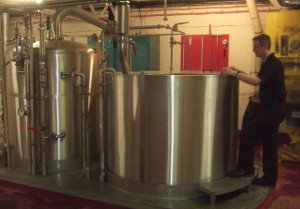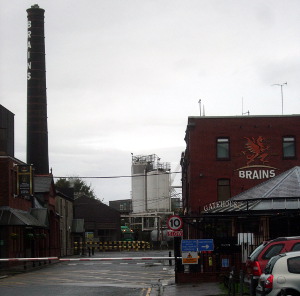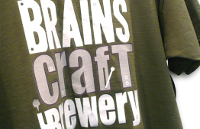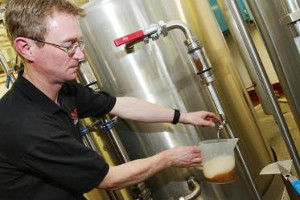At the end of October 2013 I spent a very pleasant and interesting day at S A Brain in Cardiff, helping create my first ever collaboration beer, Brabo, on the Brains Craft Brewery. This piece, which I’m publishing in several parts, documents the experience in detail — you might find it interesting as an insight into the process of brewing, Brains brewery and the craft brewery project, and the origins of the spéciale belge style of Belgian pale ale. This section on the Brains brewery and its ‘craft’ offshoot was preceded by an introduction; later sections will cover developing the recipe and the brewday itself.
Brains Craft Brewery is itself an interesting project, demonstrating one way Britain’s remaining stock of old established independent family brewers is responding to the changing market for speciality beer, and in particular the emergence of so-called ‘craft’ beer as a distinct product category.
Rather than simply stamp that slippery word on the same-old same-old, the Welsh brewer has taken the trouble not only to create an additional facility small enough to make experimentation economical, but actively sought to engage with opinion formers and consumers.
It’s a particularly striking departure as previously Brains’ image was rather staid and traditional. Founded in 1882, S A Brain & Co Ltd is still in the hands of descendants of the uncle and nephew team who developed the original brewery site on St Mary Street in Cardiff city centre. It’s been best known in the post-CAMRA era for two classic but very traditional cask ales – SA, a distinctive best bitter, and a mild simply designated Dark.
Its bread and butter beer was for decades its ordinary bitter, but this has recently been overtaken by dark bitter The Rev. James. Ironically this is a beer inherited from former arch rival Crown Buckley of Llanelli, which Brains bought out and closed down in 1998. Located in the shadow of the Millennium Stadium, the brewery is also known for a long and very successful link with Welsh rugby union and such is the demand for its beers during important matches that brewing schedules are planned around the national team’s fixtures calendar.
As one of only two surviving historic independents in Wales, Brains is a remarkable and persistent survivor in a country once swamped by national groups. In 2000 the family got the last laugh on another once bitter rival, Bass, as the iconic Burton brewer fell to Interbrew and Coors (now AB InBev and Molson Coors).
Abandoning its historic site for redevelopment as a retail complex at a time the Welsh capital was on the up following devolution, Brains snapped up Bass’s Cardiff facility, the old Hancock’s brewery, on the other side of the main railway line. This is a much larger site with a capacity well beyond the current demand for Brains’ own brands, so the company has developed a profitable second business in contract brewing, mainly on behalf of multinationals.
Now the craft brewery is diversifying the portfolio further. It happened thanks to a strong alliance between brewing and marketing – a relationship that doesn’t always run smoothly in bigger breweries, but in this case both sides were keen to tap the growing market for distinctive and unusual beers in a variety of styles.
As an old school vertically integrated brewer, Brains also had its own 270-strong pub estate with a ready market for seasonals and guest beers. The problem was that when the smallest batch you can brew is 150 barrels (245hl), experimenting is a risky business. So the case emerged for a smaller pilot plant, and luckily there was an obvious opportunity to create one.

Bill Dobson expertly flies the Brains Craft Brewery kit. An ancient disused mash tun took up twice this space, and more on the floors below.
Right in the middle of the brewery was an old and crumbling cast iron mash tun, disused and sealed since Hancocks days. Head brewer Bill Dobson made the case not only for clearing the obstruction but creating space for a more nimble installation.
Getting rid of the tun was an involved business that eventually cost more than its replacement: like many vessels in the old Victorian tower brewery it penetrated through several floors and the girders on which it rested were packed with asbestos.
When the lid was finally removed the staff were hoping for a dramatic discovery, the skeleton of a drowned brewer, perhaps, or a few cases of ancient barley wine, but it turned out to be clean and empty. “Not even a dead rat,” recalls Bill.
The craft brewery now occupies exactly half the area taken up by the old vessel, but just on the uppermost floor of the main brewery building. Fabricated to Bill’s own specification in collaboration with George Thompson of Willis European near Derby, it’s a standard British-style microbrewery with two main vessels, a mash tun and a copper, with a brew length of 15 barrels (25hl). On the floor below is a small underback made from a converted keg.

Not a prop from a 1950s science fiction film but the underback at Brains Craft Brewery, made from an old keg.
The brewery stands right next to one of the full size 250 barrel (400hl) mash tuns used for brands like Brains Bitter and Rev. James, and, unusually for a brewery of these dimensions, is fully integrated with the main brewery systems and services, an advantage a big brewer has over a standalone microbrewery.
“If we’d built it in an outhouse off in a corner somewhere,” says Bill, “it would have needed its own heating and supplies, but here it can benefit from the same economies of scales as the rest of the operation.” So the copper is heated by steam pipes from Brains’ central supply, and the whole kit is plugged into the same pipework that moves essential liquids around the entire site.
The new kit was up and running early in 2012 and right from the beginning it operated under its own distinct Brains Craft Brewery brand. There’s a separate website and visual identity, presenting a quirky, light hearted, more cosmopolitan alternative to the main brand with its rather stern and decidedly Welsh ddraig goch (red dragon).
The beers produced have run the gamut of styles, with wheat beers, green hop ales, fruit beers, golden ales featuring oatmeal, black IPAs, honey beers inspired by traditional bragawd (bragget), saisons, tripels, imperial stouts and even a chocolate beer with added bacon.
Beer writers and bloggers are cultivated by inviting them to collaborate on beers for an annual competition, judged on the day of the British Guild of Beer Writers dinner and awards ceremony in December. Last year the theme was IPAs, and two beers from that batch have since graduated to the grownup brewery, though retain the Craft Brewery branding. These are Barry Island IPA, created with cult video blogger Simon Martin; and competition winner Boilermaker, a US-style IPA matured on oak chips infused with Penderyn single malt Welsh whisky, created with Tom Sandham and Ben McFarland.
This year I’ve made the list of invitees, charged with helping create a ‘continental’ style. There have been other collaborations too, including with Brains’ licensees and pub staff.
Bill’s enthusiasm is clearly a major driver. A keen cyclist and jam maker as well as a brewer, Bill found himself on surprisingly familiar ground when he moved to Cardiff. Trained as a chemical engineer, he went straight into a job at the old Ind Coope brewery in Burton upon Trent, then owned by Carlsberg-Tetley.
“When I graduated I was offered two jobs, one at Cadbury’s and one at Carlsberg, so I chose beer over chocolate,” he recalls. “Carlsberg owned the Firkin chain back then, so I got a chance to brew on small kits when they sent me out to the Firkins.”
When Carlsberg sold its Burton brewery to next door neighbour Bass in 1997, Bill transferred to the new owner. With the additional capacity at Burton, Bass decided its Cardiff plant, then used for the Worthington brands, was surplus to requirements, and Bill was one of the team sent to organise the transfer of production. In the end the Cardiff brewery remained open as Brains took it on, and a few years later Bill found himself back there as head brewer.
Now he’s lucky to have the best of both worlds – on the main brewery he’s mainly a manager, with a team of hands-on staff, while on the craft brewery he gets to do the cooking. And unlike his colleagues in the standalone microbrewery sector, he just has to concentrate on brewing, while all the other bothersome stuff that goes with running a commercial brewery – HR, logistics, marketing, finance – goes on elsewhere.
- Brains main website: www.sabrain.com
- Brains Craft Brewery website: http://brainscraftbrewery.com
Read more about developing the recipe for my beer in the next part.









Leave a Reply